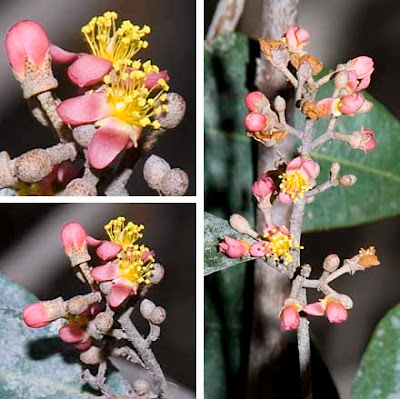I had a closer look at mangroves of Kranji Nature Trail over the last two days. And was delighted to see several rare plants in bloom!
Although tiny, the pink flowers of Dungun air (Brownlowia tersa) are quite delightful.
This mangrove understorey shrub is quite abundant in the back mangrove areas of Kranji and Sungei Buloh. The only other place I've seen them is at Woodlands Park. They are listed as Endangered.
Although they have drab leaves which are often covered in mud, they sure have pretty flowers!
I also came across two Kempudang baran (Cassine viburnifolia) trees! This tree is listed as Critically Endangered. They were both fruiting and one was also flowering.
I checked on the Bakau mata buaya (Bruguiera hainesii) here and it was flowering profusely. With lots of calyx scattered under the big tree.
Some of the fallen flowers still had their petals.
I finally managed to get a better shot of the flowers at the top of this very tall tree.
The tree is flowering so much that even the lower branches had some flowers, which were bare of flowers the last few times I visited. I didn't manage to see any propagules on the tree or on the ground.
As at the rest of Kranji which I visited recently, the nasty prickly climber Caeselpinia crista was in full bloom here too! The very pretty flowers almost make me forgive these thorny plants for the unpleasant difficulties they pose in negotiating the back mangroves.
All kinds of bees, big and small, were buzzing about the blossoms.
Other common trees were also blooming. There are many large old Tumu (Bruguiera gymnorrhiza) trees here. Most of them were also blooming, which they seem to do almost all the time. Some have pale calyx which make over enthusiastic mangrove freaks like me imagine that they are the rare Tumu berau (Bruguiera sexangula).
But a closer look shows that the flower petals have a bunch of tassels at the petal tips. B. sexangula don't have these tassels. The petals of this B. gymnorrhiza are still 'zipped' close. Each petal form a pouch that opens suddenly to explode pollen on visiting pollinators. A feature of all Bruguiera flowers. More about the exploding pouched petals here.
The Buta-buta trees (Excoecaria algallocha) have done flowering and the female trees were full of little round fruits.
The fruits have cute curlies on the tops. The fruits are eaten by the larvae of the colourful Mangrove shield bug (Calliphara nobilis). I saw several juvenile bugs among the fruits.
Prodded by Khew Sin Khoon to better observe butterflies in the mangroves, I only managed this one bad blurry shot of a brown butt settling on some Jeruju or Sea holly (Acanthus sp.) in an open, sunny part of the back mangroves.
The shores here seem to be a favourite with egrets. There were lots near the bridge, but they flew away when I crossed the bridge.Kranji Nature Trail has many nice old trees of various species here. With different kinds of roots: knee, buttress and stilt, it's quite easy to distinguish them even from afar.The mangroves here sure are awesome!
More about Sungei Buloh Wetland Reserve and the Kranji Nature Trail, see also the official Reserve website. There are many interesting programmes and walks at the Reserve.

















